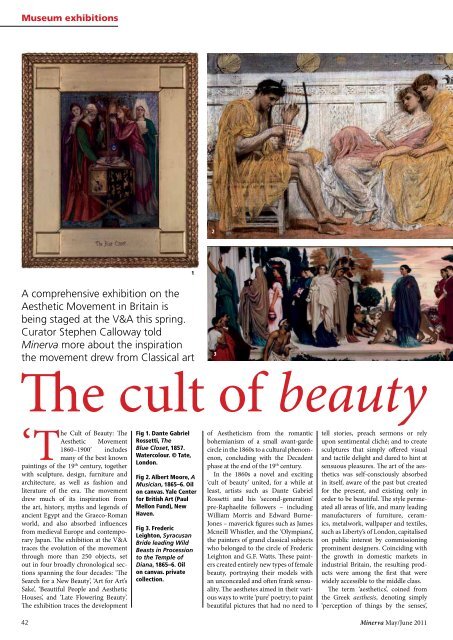Cult of beauty - Minerva
Cult of beauty - Minerva
Cult of beauty - Minerva
Create successful ePaper yourself
Turn your PDF publications into a flip-book with our unique Google optimized e-Paper software.
Museum exhibitions<br />
<strong>Cult</strong> <strong>of</strong> Beauty: The<br />
Aesthetic Movement<br />
1860–1900’ includes<br />
‘The<br />
many <strong>of</strong> the best known<br />
paintings <strong>of</strong> the 19th century, together<br />
with sculpture, design, furniture and<br />
architecture, as well as fashion and<br />
literature <strong>of</strong> the era. The movement<br />
drew much <strong>of</strong> its inspiration from<br />
the art, history, myths and legends <strong>of</strong><br />
ancient Egypt and the Graeco-Roman<br />
world, and also absorbed influences<br />
from medieval Europe and contemporary<br />
Japan. The exhibition at the V&A<br />
traces the evolution <strong>of</strong> the movement<br />
through more than 250 objects, set<br />
out in four broadly chronological sections<br />
spanning the four decades: ‘The<br />
Search for a New Beauty’, ‘Art for Art’s<br />
Sake’, ‘Beautiful People and Aesthetic<br />
Houses’, and ‘Late Flowering Beauty’.<br />
The exhibition traces the development<br />
42<br />
Fig 1. Dante Gabriel<br />
Rossetti, The<br />
Blue Closet, 1857.<br />
Watercolour. © Tate,<br />
London.<br />
Fig 2. Albert Moore, A<br />
Musician, 1865–6. Oil<br />
on canvas. Yale Center<br />
for British Art (Paul<br />
Mellon Fund), New<br />
Haven.<br />
Fig 3. Frederic<br />
Leighton, Syracusan<br />
Bride leading Wild<br />
Beasts in Procession<br />
to the Temple <strong>of</strong><br />
Diana, 1865–6. Oil<br />
on canvas. private<br />
collection.<br />
1<br />
2<br />
A comprehensive exhibition on the<br />
Aesthetic Movement in Britain is<br />
being staged at the V&A this spring.<br />
Curator Stephen Calloway told<br />
<strong>Minerva</strong> more about the inspiration<br />
3<br />
the movement drew from Classical art<br />
The cult <strong>of</strong> <strong>beauty</strong><br />
<strong>of</strong> Aestheticism from the romantic<br />
bohemianism <strong>of</strong> a small avant-garde<br />
circle in the 1860s to a cultural phenomenon,<br />
concluding with the Decadent<br />
phase at the end <strong>of</strong> the 19 th century.<br />
In the 1860s a novel and exciting<br />
‘cult <strong>of</strong> <strong>beauty</strong>’ united, for a while at<br />
least, artists such as Dante Gabriel<br />
Rossetti and his ‘second-generation’<br />
pre-Raphaelite followers – including<br />
William Morris and Edward Burne-<br />
Jones – maverick figures such as James<br />
Mcneill Whistler, and the ‘Olympians’,<br />
the painters <strong>of</strong> grand classical subjects<br />
who belonged to the circle <strong>of</strong> Frederic<br />
Leighton and G.F. Watts. These painters<br />
created entirely new types <strong>of</strong> female<br />
<strong>beauty</strong>, portraying their models with<br />
an unconcealed and <strong>of</strong>ten frank sensuality.<br />
The aesthetes aimed in their various<br />
ways to write ‘pure’ poetry; to paint<br />
beautiful pictures that had no need to<br />
tell stories, preach sermons or rely<br />
upon sentimental cliché; and to create<br />
sculptures that simply <strong>of</strong>fered visual<br />
and tactile delight and dared to hint at<br />
sensuous pleasures. The art <strong>of</strong> the aesthetics<br />
was self-consciously absorbed<br />
in itself, aware <strong>of</strong> the past but created<br />
for the present, and existing only in<br />
order to be beautiful. The style permeated<br />
all areas <strong>of</strong> life, and many leading<br />
manufacturers <strong>of</strong> furniture, ceramics,<br />
metalwork, wallpaper and textiles,<br />
such as Liberty’s <strong>of</strong> London, capitalised<br />
on public interest by commissioning<br />
prominent designers. Coinciding with<br />
the growth in domestic markets in<br />
industrial Britain, the resulting products<br />
were among the first that were<br />
widely accessible to the middle class.<br />
The term ‘aesthetics’, coined from<br />
the Greek aesthesis, denoting simply<br />
‘perception <strong>of</strong> things by the senses’,<br />
<strong>Minerva</strong> May/June 2011

















